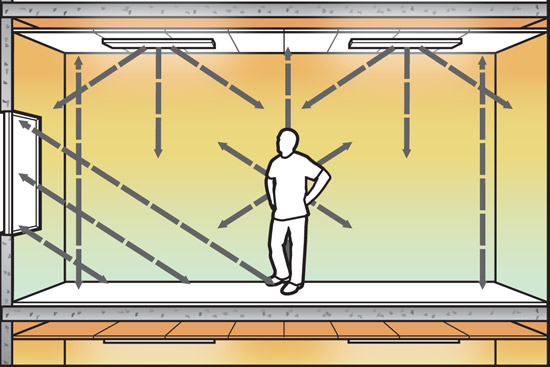Architects Warm to Chilled Ceilings
Functionally, the chilled ceiling system can be split into two general types: the cooling only panels for the majority of the building core, and cooling and heating panels to help condition the building envelope. In winter, the radiant ceiling, or sails, along the building perimeter transfer heat to the outer walls, raising the surface temperatures, which reduce the radiant heat loss from the occupants to these surfaces and avoiding discomfort. During summer months, these same panels will absorb sensible heat from these surfaces and the occupants, dissipating heat directly to the radiant ceiling in the same manner as the cooling panels in the core manage the load year-round. This can lead to greatly reduced volumes of heated or cooled supply air over convective systems, leading to fewer thermal comfort complaints.
 |
Chilled sails couple the radiant cooling effects of standard radiant panels with a convective component for increased performance. Photo © Ryan Gobuty / Gensler |
Historically, exterior heat by hot water systems used standalone radiators, while modern commercial systems are typically incorporated into floors or ceilings. There are three primary types of radiant heating systems. Electric heating panels are ceiling or wall mounted. Often, occupant sensors or timers are used to turn on the electric heating panels. These panels come with a range of radiant heat output. Low-intensity panels are lightweight and often placed into T-Bar ceilings, or attached to surfaces, such as under an occupant's desk. Higher intensity panels may require more extensive installation steps due to the weight and dimensional aspects of the panels.
 |
|
Image courtesy of Price Industries |
The second type, electrically resistance cables, are generally used by being attached to the underside of wood floors, embedded in a material such as gypcrete or tile substructures, or in wall cavities. These typically offer good thermal capacity and consistent room surface temperatures, though this system can be slow to respond to temperature changes due to the thermal mass of the material they are attached or embedded into.
The third type is hydronic or water-based systems. Hydronic radiant heating systems pump heated water from a boiler through tubing embedded into floors or ceiling materials, or through baseboard fin tube heaters. Wall- and ceiling-mounted radiant panels are usually made of aluminum and have water tubing attached to the back of the panel.
Ways to Heat and Cool a Building: Radiant Technology vs. All-Air
Management of heat loads can be classified into two different types: all-air HVAC systems and hybrid systems. All-air systems have been the most prominent in North America during the 20th century and have been in use since the advent of forced air conditioning. The majority of commercial spaces are still heated and cooled by conventional HVAC, which typically has a central air handling unit, or rooftop unit, that delivers cool or warm air to satisfy the building load and maintain the desired thermal conditions in the occupied zone. These conventional systems use high-volume air flows, bring them to the supply air temperature required to maintain the zone set point, and distribute the conditioned air throughout the building via ducts. Air diffusers are mounted in the zone to distribute the supply air. In most cases, the volume of supply air required to cool or warm the space is higher than the ventilation requirements in order to properly mix the occupied space to obtain the uniform temperature in the occupied zone. Draft is not uncommon and is often the primary complaint from occupants. Draft complaints are common when the supply air volume is the minimum due to low thermal loads in the occupied space.
Hybrid systems often have two components: an air-side ventilation system and a water-side heating/cooling system. The air side is typically designed to meet the ventilation requirements for the occupied space, as well as satisfy all latent loads. Ideally, it is a 100 percent outside air system and simply provides the volume of air required for ventilation and dehumidification. The water side is designed to meet the balance of the sensible cooling and heating loads. These loads may be handled by water-based products, such as radiant panels, which transfer heat mainly by thermal radiation, and chilled sails, which transfer heat using a combination of thermal radiation and natural convection. Because these radiant systems use water to condition a space's sensible load, and rely on a separate ventilation system to provide ventilation and satisfy latent loads, there is a greatly reduced supply air volume requirement and a significant reduction in break horse power due to the energy density of water compared to air. Using water takes less energy to move the same amount of thermal energy into and out of the occupied space when compared to an all-air system.









